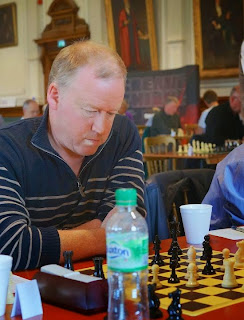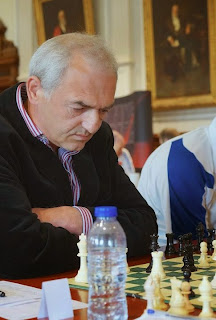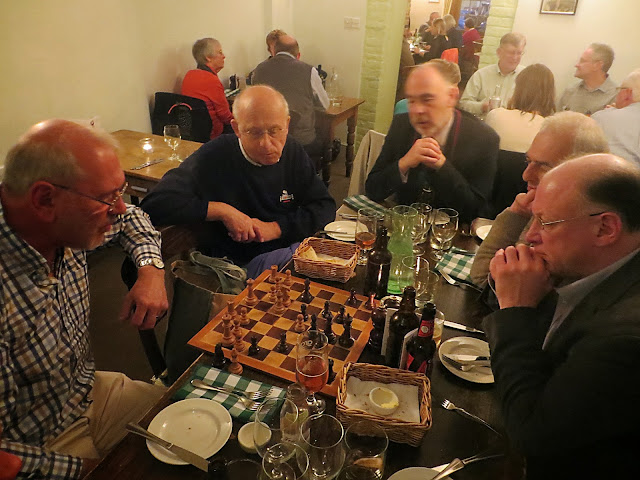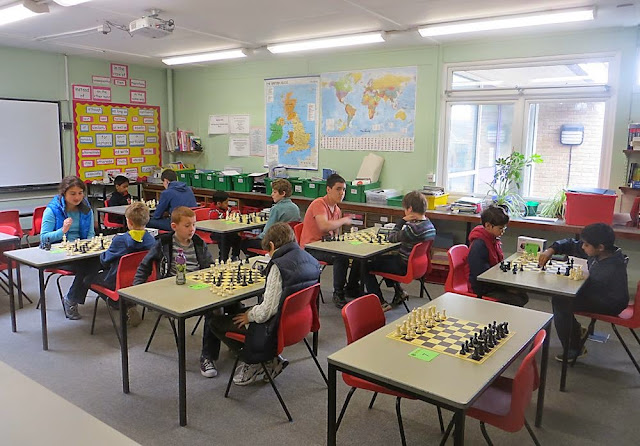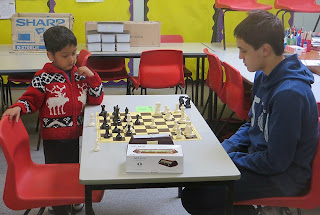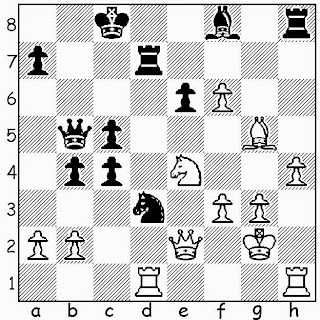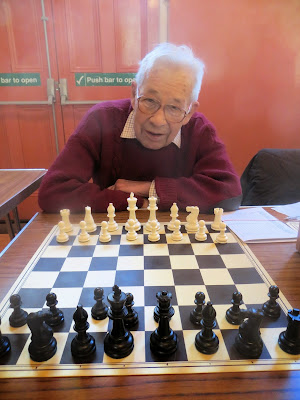Back in January, at the Under 160 match between Cambridgeshire and Suffolk, one game featured the Chairman of the Bury Area League,
Ole Bay-Petersen and the President of the Suffolk League,
Colin Roberts. These two have different job titles, but in effect they both do the same job in the two leagues.
Their game was an interesting one, which both players have kindly annotated in some detail. Most of the text is Ole's, but the text in red is Colin's.
"Since I retired and returned to chess ten years ago, I've probably played fewer than a dozen games against Colin, but I've enjoyed them all - even those I lost - as Colin is a highly enterprising and uncompromising player. If memory serves, we haven't drawn a single game with each other. A few years ago, after a long and exhausting battle, my draw offer was promptly rejected by Colin (who then went on to lose). "I play to win" was the motto of my illustrious compatriot Bent Larsen. It may well be Colin's motto, too!
Although our game at Newmarket was flawed, it was very tense and exciting. I know Colin to be a Slavophile, so it was no surprise when the opening turned into the complex and super-sharp Botvinnik variation in the Semi-Slav. This is of course a fashionable and heavily analysed variation, and the first half of the game, as it turned out, consisted of "book" moves. This wasn't actually a result of home preparation (neither of us knew we would be playing one another), and - as far as I can recall - I haven't played the Botvinnik variation with either colour in a serious game since I was young (and that was some time ago). Naturally, I've played over many GM games with that variation, and some of the lines must have lodged themselves somewhere in my memory cells."
"I, too, have enjoyed my games against Ole. I think there have been nearer half a dozen than a dozen, but all have been hard-fought. Ole is a tough and very courteous opponent.
The Botvinnik Variation of the Semi-Slav was once described by Anatoly Karpov as "one of the sharpest and most fascinating variations in opening theory" and it always provides exciting, unbalanced games. I agree generally with Ole's analysis and I have not duplicated his comments but rather added my thought to his."
White: Ole Bay-Petersen (Cambridge City) Black: Colin Roberts (Bury St Edmunds)
1. d4 d5 2. c4 c6 3. Nf3 Nf6 4. Nc3 e6 (introducing Rubinstein's Semi-Slav). 5. Bg5 (the more solid e3 is the Meran system. It shuts in the B on c1, for the time being) 5... dxc4 (Black could also try ... Nbd7 followed by 6... Qa5, transposing to the Cambridge Springs variation. Or 5... h6 [the Moscow variation] 6. Bh4 dxc4 7. e4 g5 8. Bg3 b5 etc).
But the Mainline Botvinnik is much more fun!
6. e4 b5 7. e5 h6 (this move transforms the gambit from a White one to a Black one). 8. Bh4 g5 9. Nxg5 (here I also considered playing Bg3 instead, which I dimly remembered a GM playing against Shirov, who continued 9... Nd5 and won a long, tough game).
After 9. Bg3, I am a pawn up rather than one down. Also possible is 9. exf6 gxh4 10. Ne5, but I don't think that is particularly good for White.
9... hxg5 (Black can also try the dubious Alatortsev line: ... Nd5 10. Nxf7 Qxh4 11. Nxh8 Bb4 12. Rc1, but this may not be to everyone's taste).
I find it hard to believe that the 9... Nd5 line can be at all sound.
10. Bxg5 Nbd7 (Be7 is also possible). 11. g3 (Colin told me afterwards that he was expecting the immediate exf6, but I didn't like the continuation 11... Bb7 12. g3 c5 13. d5 Qc7/Bh6. Later I found out that Shirov has played the interesting 11... Rg8 12. h4 Rxg5 13. hxg5 Nd5 14. g6 with great complications).
In his fabulous book on the Semi-Slav, Matthew Sadler gives 11. exf6 Bb7 12. g3 c5 13. d5 as the main line, so I think Ole's fears were unfounded.
11... Bb7 12. Bg2 Qb6 (the most common continuation these days. Botvinnik himself preferred 12... Qa5 here). 13. exf6 O-O-O 14. O-O c5 (here the tempting ... Ne5, which Black in fact played two moves later, allows a thematic and well-known queen sacrifice: 15. dxe5 Rxd1 16. Rxd1 with full compensation for the queen. In his excellent Fire On Board, Shirov mentions that the ageing Botvinnik insisted the sacrifice was unsound, but even as a teenager Shirov knew it was good). 15. d5 (a natural and strong move. White doesn't want to trade bishops, except if he can get his own bishop or knight into the centre).
And we have transposed to the mainline.
15... b4 (The tension mounts. Black obviously has full compensation for the pawn deficit, and his pawn avalanche on the queenside looks alarming).
Again, this move is the mainline according to Sadler.
16. Rb1
(This was the position in the photo, and the critical moment in the game. Until now Colin had been playing quickly and confidently, but now he sank into thought and caught up with me on the clock. I had played 16. Rb1 fairly quickly, because I vaguely remembered having seen it before when I played my previous move (16. Na4 is the main alternative). Shirov says that the move "somehow doesn't seem so logical to me, but it's terribly dangerous." Colin evidently agreed, and rejected the sacrifice. If 16... bxc3 17. bxc3 Qa6 18. Rxb7 K/Qxb7 19. dxe6(+), followed by e6-e7).
16. Na4 is more usual. Rb1 was played by Topalov against Kramnik in Dortmund in 1996. I had not played this line for some time and I knew that taking the knight was dangerous, but I wanted to reconvince myself just how dangerous it was! Kramnik rejected the sacrifice, too.
16... Ne5 (instead a popular continuation is ... Qa6 17. dxe6 Bxg2 18. e7 Bxf1 19. Qd5 etc. I have no idea whether Colin's ... Ne5 is a novelty or a 'book' move. I'd never seen this move and was now completely on my own. The move looks very promising: it not only centralises and energises the knight, it also pins down the d5 pawn, and indeed threatens to capture either d5, or perhaps the knight on c3, so my next move looks forced.)
I don't know whether Ole is being excessively kind to this move. I had the same thoughts as he when playing it. Ive not seen it written about though, which gives me doubts.
17. Qe2 Nd3 (renewing the threat of capturing on d5/c3, and parking a monstrous knight - or 'octopus', as GM Keene calls it - on an ideal square (Steinitz compared a protected knight on the 6th rank to a rusty nail in the opponent's knee!).
Strange analogy. Steinitz was a little unusual but why a rusty nail and why the knee? Taking the knight looks equally dangerous to me. I was happy with the knight on d3 at this stage though.
18. dxe6 Bxg2 (... Qxe6 19. Bxb7+ Kxb7 20. Qxe6 fxe6 21. Ne4 looks more circumspect).
I wanted to keep the queens on to maximise attacking chances (I am a pawn down, after all) and, as Ole implied in his introduction, I find it hard to do circumspect! Perhaps this is partly why I have such a low proportion of drawn games.
19. Kxg2 (the tempting 19. e7 Bxf1 20. exd8Q+ Qxd8 21. Kxf1 was equally good) 19... fxe6 (again Black could have played ... Qxe6, but Colin preferred to retain his queen). 20. Ne4 (the knight has done its duty on c3 and now seeks pastures new. It also deters Bd6). 20... Qc6 21. f3 Rd7 (probably aiming for h7).
... Rh7 at some stage was a thought, as was Rhd8 after the bishop moves, but I'm unconvinced about my move now. Perhaps I should not fear ... Bd6, as if Nxd6 and I capture the knight, my own cavalry on d3 is perhaps a little harder to dislodge?
22. h4 (a reminder that White is still a pawn up, and both f6 and h4 have coronation ambitions). 22... Bh6 (it's understandable that Colin wants to develop his kingside pieces, but after my next move he changes his mind, wasting valuable time). 23. Rh1 (not really necessary. If ... Bxg5 24. Nxg5 looks good for White. I thought, however, that 23... Bxg5 24. hxg5 was even better, creating two connected passed pawns, with two more connected passed pawns close behind! After Black's next move, I began to feel optimistic.)
I agree that ... Bh6 is poor. ... Bxg5 is not a good idea, whether White takes back with the knight or the pawn.
23... Bf8 24. Rbd1 (beginning to undermine Nd3 with the threat of playing b3. 24... Qb5 (indirectly defending the knight, but the move looks dubious to me, as it leaves the pawn on e6 undefended. (see diagram)
Probably Black should have tried Qd5, despite the baleful glare of Rd1; or maybe Ne5, though here White retains his advantage after 25. Rxd7 Qxd7 [Nxd7? Qxc4] 26. Rd1 etc).
I think whereas Ole has continued to play well, my moves 21 to 24 were weak and the game has slipped away. Hence it is hard to find a good move here.
25. Rd2 Bh6 (a surprising, some might say stubborn, return of the hapless bishop. Here I thought Colin was beginning to lose the thread of the game. Afterwards I realised that this was actually part of a cunning plan to awaken his slumbering knight by tactical means).
That was the plan, but it is too late, I fear. I think that 'stubborn' is unfair; I am just having difficulty getting my pieces moving now.
26. Rhd1 Bxg5 27. Nxg5 (attacking e6, and better than hxg5, which would allow Black to double rooks on the h-file). 27... Rxh4 (I must admit that this move came as a nasty shock. I'd actually been very conscious of the danger of a fork on f4, and yet I completely overlooked the possibility of the rook sacrifice. When I'd calmed down, I realised that Black's move, though tactically alert, was based on a serious oversight).
It was more of a final attempt to bluff! White is unstoppable now, of course.
28. Qxe6 (with the fall of this pawn, the Black position collapses: I'm threatening Rxd3, followed by gxh4, and also f7 or first Qe8+. And if 28... Rhd4, I have 29. Qe8+ Kb7 [... Kc7 Ne6+] 30. f7 etc.) 28... Rh8 (this doesn't help, but Black wants to stop the deadly Qe8+ and f7). 29. Nf7 Rf8 (saving the Rook but losing the Queen) 30. Nd6+ Resigns
"In the final position White has a plethora of passed pawns, and all his pieces are centralised, whereas the Black king's rook is back where it came from, his queen's rook is pinned, his queen - nestling among the pawns - is out of play, and the Black knight is still looking fine but doing nothing.
It's ironic that the White knight, which remained en prise for several moves, ended up - via e4, g5, and f7 - on a square corresponding to that of the Black knight, but whereas the latter could only dream of delivering a family fork, the White knight succeeded in doing exactly that.
Despite mutual inaccuracies, I found this a satisfyingly complex and engrossing battle. I think I might try the Botvinnik variation again, as either White or Black, if given the chance. And I'm certainly looking forward to my next battle with Colin!"
"I always look forward to games with Ole as they are always fun and played in a totally sportsmanlike fashion. In this game, perhaps I shaould have allowed the queens to come off after all, but then I might have faced a long and losing ending.
To the casual observer, this may not look a very good game; there is a lot of theory and then Black plays inaccurately and allows White, who plays far more sensibly, to win, but not before attempting a totally unsound sacrifice! But it felt very different when we were playing and we both enjoyed the game.
I congratulate Ole and look forward to our next encounter over the board."


